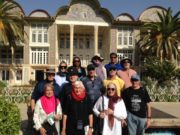Ten days in Iran: 1
From September 7-17, Susana and I were part of a 12-person tour of Iran organized by The Nation magazine, from Tehran to Kashan to Isfahan to Persepolis to Shiraz, in the company of an extraordinarily well-prepared and multilingual guide (Ali Sadrnia, the tall man in the back row of the photo of our group, taken in Shiraz). This brief visit to an immense country, with its ancient language and history and its complex present-day conflicts, helped us reframe our many questions about the Islamic Republic and to formulate new ones. Here is the first of a series of my reflections on this trip.
Before reaching Tehran, we stopped for a few days in Dubai, where we met up with our fellow travelers. The contrast between the extreme opulence coupled with appalling exploitation in the Emirates, and what we saw and experienced in Iran, will merit another note, but for now, let’s get right to Tehran, a big, chaotic city of reckless motorists, glaring propaganda, palaces and hovels. It has been the capital of Iran only since A.D. 1796, which is only yesterday in a nation whose unity and empire date back to 625 B.C. Tehran is the 32nd national capital in all those centuries, as borders and alliances shifted, requiring new sites of power, so it has nowhere near the antiquity or urban credentials of, say, Isfahan, which in the 11th century A.D. was already one of the largest cities in the world and was also the national capital in two periods, or the southern city of Shiraz, a leading center of arts and letters in the 13th century and the national capital just before Tehran. I’ll tell you about those places later.
Tehran is more modern, more hectic, more populous (approximately 10 million in 2016, about 11% of the national population) and more obviously stratified (rich northern vs. poor southern neighborhoods) than those others, but you won’t want to avoid it, because today it is the great power center, political and religious power. So gird yourself against the traffic, the pollution and earthquakes (frequent and sometimes severe). Winters can be extremely cold with heavy snow, but in September we were breathing soot-filled air of 30º to 40º C (86 to 104º Fahrenheit).
Our tour was organized to cram as much as possible into our short stay, so as soon as we cleared immigration and even before we got to our hotel, we were rushed to the Carpet Museum, where I learned more than I had ever suspected about the famous Persian carpets. (See link to website, below) I hadn’t before given carpets much thought, but that craftsmanship, the immense skill and variety and intricate design, was a good introduction to the cultural values and traditions of this land.
The next day, after a good night’s sleep in the very comfortable Espinas Hotel, with a fabulous Iranian buffet breakfast, we visited the National Museum with its splendid archaeological collection, the Glass and Ceramics Museum, and the Crown Jewels. I’ll save those for tomorrow’s note, as spurs to reflections on the vast, splendid history of what was once the world’s largest empire, with close to half the entire world population.
